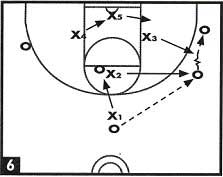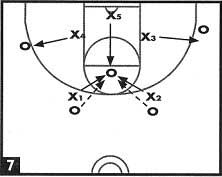

Amoeba Defence
The following article was provided by Steve Mergelsberg, Assistant Basketball Coach, Rutgers University - Newark, Newark, N.J., U.S.A.
While living in Las Vegas and coaching at Bishop German High School, I had the opportunity to sit down with Tarkanian and have him explain the amoeba defence. One thing that he said always stuck with me. "Our man defence was good that night, but we had 12 to 15 minutes in that game where our amoeba defence just took Duke out of everything," Tarkanian said. "It got us going on a lot of fast breaks and scoring streaks."
Basic Amoeba Alignment
The following is the alignment for setting up the amoeba defence. This is the setup that your defenders need to be in when the offensive team is bringing the ball up-court. X1 is responsible for picking up the ball handler as soon as he or she crosses half-court. Xl's main job is to harass the ball handler, making it tough to dribble up the floor and pass to a teammate. X2 patrols the free-throw-line area looking for flash cuts to the high-post area. The tandem of X1 and X2 should be the quickest players on your team. X3 and X4 are halfway between the free-throw line and the baseline, facing at an angle toward the sideline. X5 is the "hoop defender," the last line of defence guarding the basket. X5 stands as far back as needed to see the whole floor and must never get beat from behind. |
 |
When the ball is passed from the point to the wing, X2 charges out to play the opponent with the ball. X1 retreats to guard the free-throw area. When the ball handler initiates a dribble, X3 sprints out to double team with X2. X5 moves over to the block area, and X4 rotates to become the hoop defender. If the ball is passed back from the wing, X2 goes back to his or her original spot at the foul line, and X1 pops out to the top, back to his or her original spot. |
 |
X1 and X4 are responsible for covering the shaded area on any pass from the double team. The ball is now double-teamed at the wing. X1 can either deny the point player or encourage a reverse pass from the double-team for a possible steal. Tarkanian believed that if X2 and X3 are doing a good job of double-teaming, any pass cross-court will be high enough in the air to be picked off by either X4 or XI, depending on where the pass is thrown. |
 |
Defending wing-to-corner passes.
When the ball is passed from the wing to the corner, X5 comes flying out and closes out on the corner player with the ball. When X3 sees that the ball is being passed from the wing to the corner, he or she pivots and sprints to the low-post area, in what Tarkanian called an "X-cut." X3 fronts the low-post offensive player. The gamble here is when the corner offensive player gets the ball and X5 is sprinting toward the player with the ball and will see the low-post player open, not knowing that X3 is on the way to that area. Many times, in a panic, the corner player instantly passes to the seemingly open post player and X3 comes up with a steal. Tarkanian believes that if X5 is closing out and tracing the ball, a good pass will be impossible to deliver and X3 will come up with a steal. X1 and X4 are still responsible for the weak side of the floor. X2 denies the reverse pass back to the wing from the corner. Any attempt to pass to the point will be picked off by XI. |
 |
Defending Cross Court Skip passes
The rule on any skip pass to the other side of the floor is that the closest player covers the player with the ball.
The pass is complete from the corner. X4 would be the closest defender to the ball, so he or she would cover the receiver. X3 goes from low post to low post, and X5 would become the hoop defender. X2 retreats to the middle to provide any help that is needed, and X1 would deny the pass to the point. |
 |
This diagram shows the initial entry pass, as seen in Diagram 2, but here you have an offensive player on the high post. In this case - just as in Diagram 2 - when the ball is passed to the wing, X2 sprints out to defend, and X1 drops down to play the offensive player in the high post. This leaves the point guard alone, the theory being that he or she cannot harm you by being that far from the basket. If the offensive wing player with the ball takes a dribble, X3 comes out to defend and double-teams with X2. XI, who is denying the high post, can anticipate a pass back to the point and go for the steal. At this point, if the ball is passed from the wing to the corner, X5 sprints out and plays the corner player. X3 "X-cuts" and goes to defend the block area and X4 becomes the hoop defender. X4 and X1 are responsible for stealing anything thrown crosscourt from the block area and higher. This may seem like a lot to cover, but Tarkanian believed that if your defenders are playing good, hard-nosed defence, the only pass that will be thrown is one high in the air that X4 and X1 have a great chance for a steal. |
 |
Amoeba vs Two-Guard Front
Some offences try to beat the amoeba by utilizing a two-guard front.
If the offence plays a two-guard front, X1 and X2 match up with the guards. If the offensive team puts a player at the high post, X5 comes up and guards behind. This encourages the offender to make a pass into the high post, which is what you want to happen. If the ball is passed into the high post, X1 and X2 immediately double down and create a triple-team at the high post. This may cause the high-post player with the ball to panic and either give up his dribble or throw an errant pass. X3 and X4 anticipate any passes into their areas and go for the easy steal. |
 |
Beating the Triple-Team
If the triple-team in the high-post area fails and the high-post player manages to get a pass to either the wing or the corner areas, your defenders react accordingly.
When the ball is passed to the wing from the post, X1 retreats to the high-post area and denies the post. X2 plays the wing player, and X3 denies the pass to the corner or encourages a pass and gets a trap or steal in the corner. X2 may sprint down and double-team the corner player, depending on the game situation. X4 becomes the hoop defender and X5 guards the low post. XI, who is playing the post, must anticipate passes to the point from the corner, the wing and the cross-court. This is one of the reasons why X1 and X2 must be your quickest players. X1 and X2 must always be alert and can anticipate defensively. If the ball is passed to the corner from the post or wing, X3 sprints out to play the corner player, X5 drops to the low-post area, and X4 becomes the hoop defender. XI denies the post and X2 denies the pass back to the wing from the corner or encourages the pass and looks to make a steal. A pass from the corner to the point weak-side guard can be picked off by X1 and taken the other way for an easy layup. |
 |
Page Reference
If you quote information from this page in your work, then the reference for this page is:
- MERGELSBERG, S. (2005) Amoeba Defence [WWW] Available from: https://www.brianmac.co.uk/basketball/amoeba.htm [Accessed